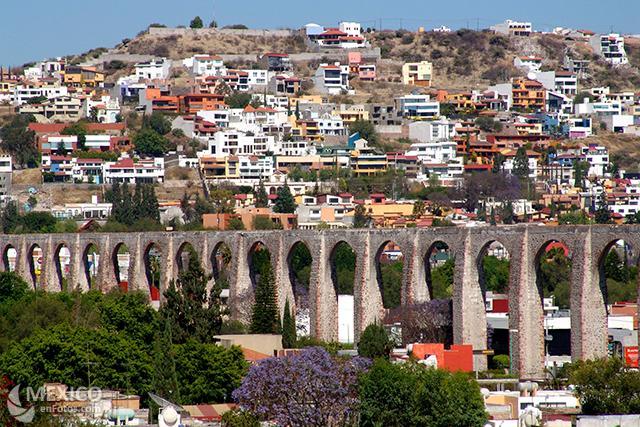
The city of Queretaro is an excellent point to begin your colonial Mexico visit. A commercial center of over half a million inhabitants, it lies at the junction of two major interstate highways, routes 57 and 45. Located only two and a half hours from Mexico City (220 km), Queretaro has become a satellite of sorts for the capital. Several large manufacturing plants have relocated on the city’s outskirts, and thousands of businessmen commute between the two cities. Its economy consists of agriculture, livestock-raising and manufacturing. It is also a major center for amethyst, opal and topaz cutting. Its mines produce mercury, zinc and lead.
The city has preserved its historic downtown and taken steps to beautify many areas. The Historic Monuments Zone of Queretaro was named a UNESCO World Heritage site in 1996. The property was inscribed on the basis of two if its cultural criteria and considering that the site is of outstanding universal value and an exceptional example of a colonial town whose layout symbolizes its multiethnic population. It is also endowed with a wealth of outstanding buildings, notably from the 17th and 18th centuries.
Queretaro holds several treasures, and a friendly sense of civic pride prevails. The historic city center is filled with lovely colonial mansions, immaculate pedestrian alkways (andadores) and quaint plazas little changed since colonial days. Explore the city via a double-decker bus that operates in the downtown historic center.
The city was founded in 1531 by Franciscan monks. It is both literally and figuratively an important crossroads of Mexican history. Four of the most significant events in Mexico’s history took place here. First, plans for Mexican independence from Spain were hatched here in 1810. Second, in 1848, the Treaty of Guadalupe Hidalgo was ratified in Queretaro, ending the Mexican-American War, and surrendering 55% of Mexico’s territory to the U.S. Third, in 1867, Austrian Archduke Maximilian was executed on a hill overlooking the city. And finally, in 1917, the Mexican Constitution was signed here.
The State offers a wide variety of natural, historic and recreational attractions. Its northern region is home to pine-clad mountains (the Sierra Gorda), giving way to rolling hills and fertile farmlands to the south. Most visitors spend their days exploring the state’s handsome capital city adorned with lovely architecture, quiet plazas and pedestrian walkways lined with color-splashed, colonial-era homes and mansions.
Day trips to outlying areas include the attractive villages of Tequisquiapan and San Juan del Río. The Sierra Gorda region north of Queretaro City is home to several splendid Franciscan missions, founded by Junípero Serra (of California mission fame) in the 1750s. The Franciscan Missions in the Sierra Gorda of Queretaro were designated a UNESCO World Heritage site in 2003.
For golfers, the state offers 81 holes of play, and some fine country club facilities. The state’s renowned symphony orchestra performs at the modern Auditorio Josefa Ortiz de Dominguez. Several mineral spas around Tequisquiapan are popular for therapeutic benefits. The archaeological sites of Toluquilla and Las Ranas near the city of San Joaquín showcase Chichimeca and Huasteca influences.
